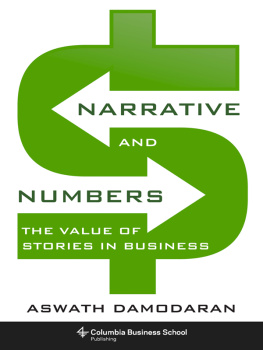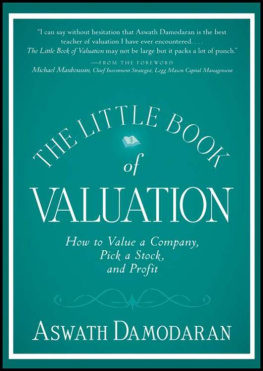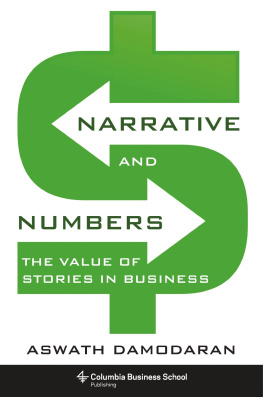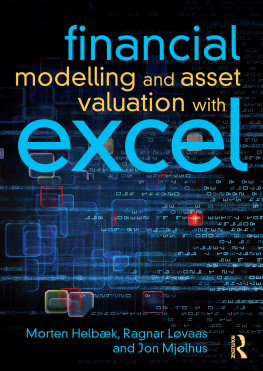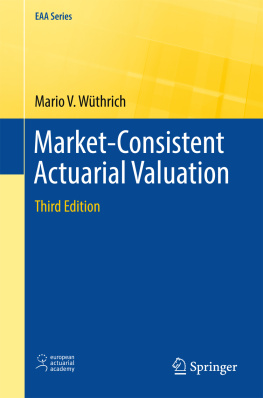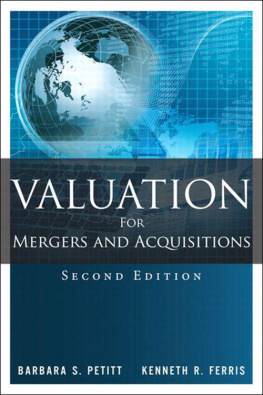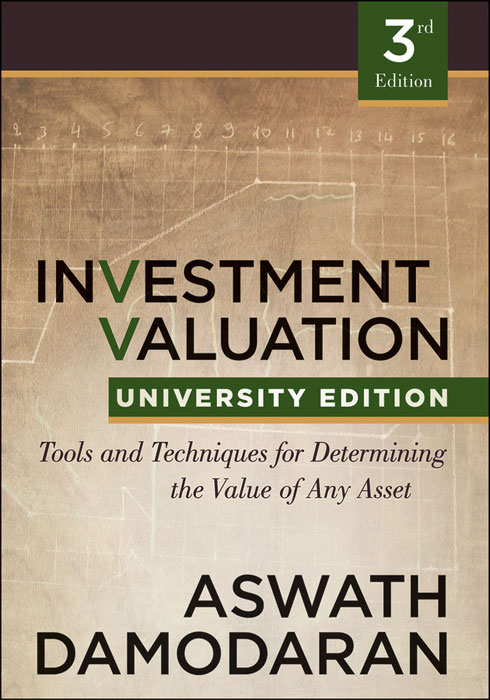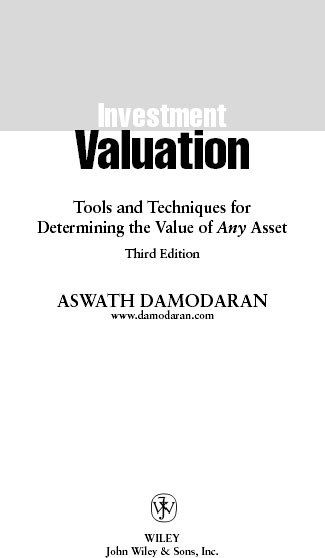Founded in 1807, John Wiley & Sons is the oldest independent publishing company in the United States. With offices in North America, Europe, Australia, and Asia, Wiley is globally committed to developing and marketing print and electronic products and services for our customers' professional and personal knowledge and understanding.
The Wiley Finance series contains books written specifically for finance and investment professionals as well as sophisticated individual investors and their financial advisors. Book topics range from portfolio management to e-commerce, risk management, financial engineering, valuation, and financial instrument analysis, as well as much more.
For a list of available titles, please visit our Web site at www.WileyFinance.com .
Copyright 2012 by Aswath Damodaran. All rights reserved.
Published by John Wiley & Sons, Inc., Hoboken, New Jersey.
Published simultaneously in Canada.
No part of this publication may be reproduced, stored in a retrieval system, or transmitted in any form or by any means, electronic, mechanical, photocopying, recording, scanning, or otherwise, except as permitted under Section 107 or 108 of the 1976 United States Copyright Act, without either the prior written permission of the Publisher, or authorization through payment of the appropriate per-copy fee to the Copyright Clearance Center, Inc., 222 Rosewood Drive, Danvers, MA 01923, (978) 750-8400, fax (978) 646-8600, or on the Web at www.copyright.com . Requests to the Publisher for permission should be addressed to the Permissions Department, John Wiley & Sons, Inc., 111 River Street, Hoboken, NJ 07030, (201) 748-6011, fax (201) 748-6008, or online at http://www.wiley.com/go/permissions .
Limit of Liability/Disclaimer of Warranty: While the publisher and author have used their best efforts in preparing this book, they make no representations or warranties with respect to the accuracy or completeness of the contents of this book and specifically disclaim any implied warranties of merchantability or fitness for a particular purpose. No warranty may be created or extended by sales representatives or written sales materials. The advice and strategies contained herein may not be suitable for your situation. You should consult with a professional where appropriate. Neither the publisher nor author shall be liable for any loss of profit or any other commercial damages, including but not limited to special, incidental, consequential, or other damages.
For general information on our other products and services or for technical support, please contact our Customer Care Department within the United States at (800) 762-2974, outside the United States at (317) 572-3993 or fax (317) 572-4002.
Wiley also publishes its books in a variety of electronic formats. Some content that appears in print may not be available in electronic books. For more information about Wiley products, visit our web site at www.wiley.com .
Library of Congress Cataloging-in-Publication Data:
Damodaran, Aswath.
Investment valuation : tools and techniques for determining the value of any asset / Aswath Damodaran.3rd ed.
p. cm.(Wiley finance series)
Includes bibliographical references and index.
ISBN 978-1-118-01152-2 (cloth); ISBN 978-1-118-20654-6 (ebk);
ISBN 978-1-118-20655-3 (ebk); ISBN 978-1-118-20656-0 (ebk)
ISBN 978-1-118-13073-5 (paper); ISBN 978-1-118-20657-7 (ebk);
ISBN 978-1-118-20658-4 (ebk); ISBN 978-1-118-20659-1 (ebk)
1.CorporationsValuationMathematical models. I. Title.
HG4028.V3 D353 2012
658.15dc23
2011052858
I would like to dedicate this book to Michele, whose patience and support made it possible, and to my four childrenRyan, Brendan, Kendra, and Kiranwho provided the inspiration.
Preface to the Third Edition
This is a book about valuationthe valuation of stocks, bonds, options, futures and real assets. It is a fundamental precept of this book that any asset can be valued, albeit imprecisely in some cases. I have attempted to provide a sense of not only the differences between the models used to value different types of assets, but also the common elements in these models.
The past decade has been an eventful one for those interested in valuation for several reasons. First, the growth of Asian and Latin American markets brought emerging market companies into the forefront, and you will see the increased focus on these companies in this edition. Second, we saw the havoc wreaked by macro-economic factors on company valuations during the bank crisis of 2008, and a blurring of the lines between developed and emerging markets. The lessons I learned about financial fundamentals during the crisis about risk-free rates, risk premiums and cash flow estimation are incorporated into the text. Third, the past year has seen the influx of social media companies, with small revenues and outsized market capitalizations, in an eerie replay of the dot-com boom from the late 1990s. More than ever, it made clear that the more things change, the more they stay the same. Finally, the entry of new players into equity markets (hedge funds, private equity investors and high-frequency traders) has changed markets and investing dramatically. With each shift, the perennial question arises: Is valuation still relevant in this market? and my answer remains unchanged, Absolutely and more than ever.
As technology increasingly makes the printed page an anachronism, I have tried to adapt in many ways. First, this book will be available in e-book format, and hopefully will be just as useful as the print edition (if not more so). Second, every valuation in this book will be put on the web site that will accompany this book ( www.damodaran.com ), as will a significant number of datasets and spreadsheets. In fact, the valuations in the book will be updated online, allowing the book to have a much closer link to real-time valuations.
In the process of presenting and discussing the various aspects of valuation, I have tried to adhere to four basic principles. First, I have attempted to be as comprehensive as possible in covering the range of valuation models that are available to an analyst doing a valuation, while presenting the common elements in these models and providing a framework that can be used to pick the right model for any valuation scenario. Second, the models are presented with real-world examples, warts and all, so as to capture some of the problems inherent in applying these models. There is the obvious danger that some of these valuations will appear to be hopelessly wrong in hindsight, but this cost is well worth the benefits. Third, in keeping with my belief that valuation models are universal and not market-specific, illustrations from markets outside the United States are interspersed throughout the book. Finally, I have tried to make the book as modular as possible, enabling a reader to pick and choose sections of the book to read, without a significant loss of continuity.
CHAPTER 1
Introduction to Valuation
Every asset, financial as well as real, has a value. The key to successfully investing in and managing these assets lies in understanding not only what the value is, but the sources of the value. Every asset can be valued, but some assets are easier to value than others, and the details of valuation will vary from case to case. Thus, valuing of a real estate property will require different information and follow a different format than valuing a publicly traded stock. What is surprising, however, is not the differences in techniques across assets, but the degree of similarity in the basic principles of valuation. There is uncertainty associated with valuation. Often that uncertainty comes from the asset being valued, though the valuation model may add to that uncertainty.



